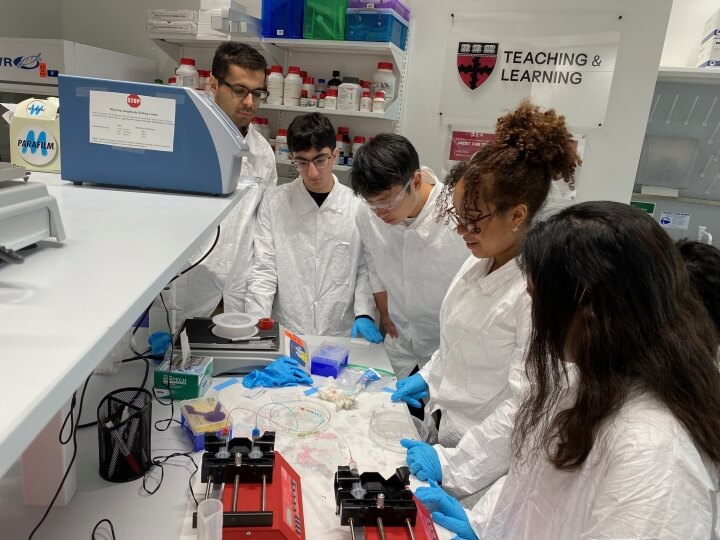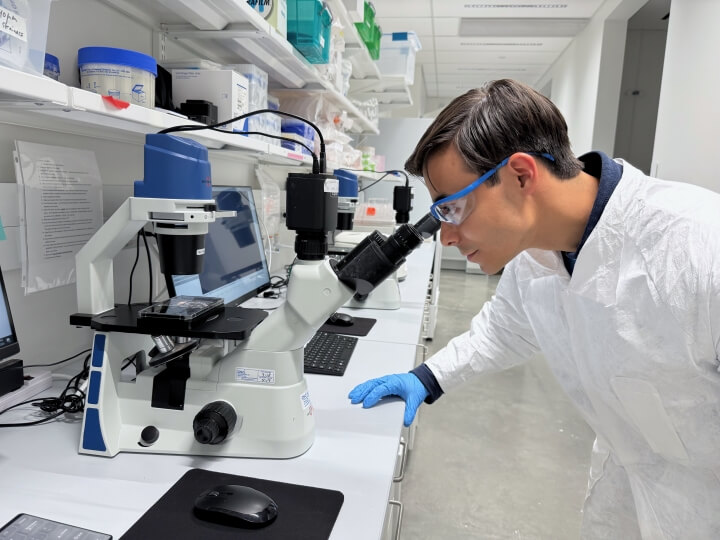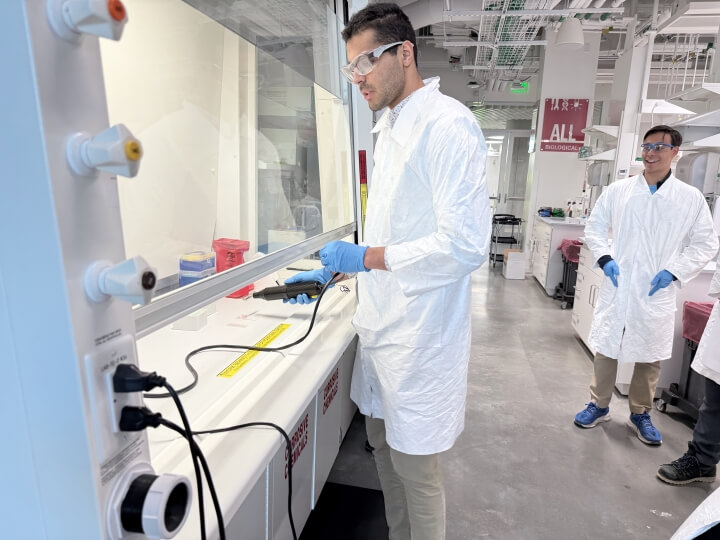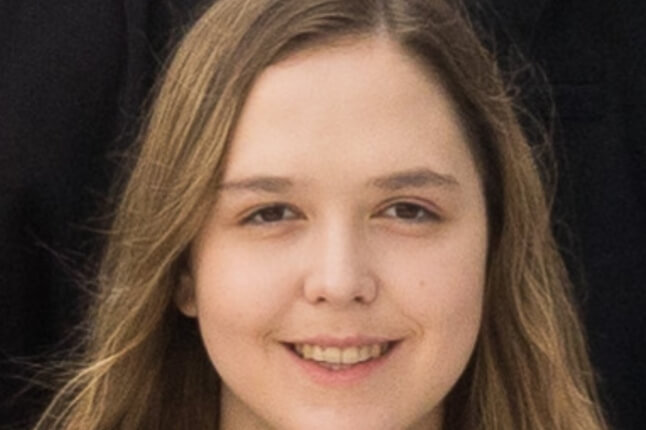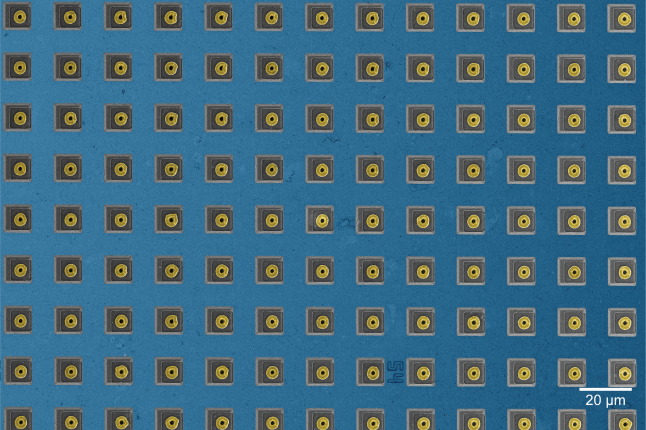News
BioSTAR participants Nureldin Mohamed, Maher Harp, Jeffrey Zhou, Arlette Duran and Aryenne Ysabelle Rodrigo work in the Active Learning Labs
Kieran McDaniel wanted to advance his laboratory skills. McDaniel, a second-year bioengineering concentrator at the Harvard John A. Paulson School of Engineering and Applied Sciences (SEAS), had some previous exposure to wet lab research, but still felt like there was a lot more to learn, especially when it came to working with cells.
Harvard’s Wintersession provided McDaniel with a chance to gain the skills he wanted. He was one of nine SEAS students to participate in the Bioengineering Science, Technology and Research (BioSTAR) program. Organized by the SEAS Active Learning Labs, McDaniel and his classmates spent four days in January learning how to culture mammalian cancer cells in a laboratory setting, practicing fundamental techniques that will help them succeed in a wide range of labs as they approach the second half of their time at Harvard.
“I wanted to gain more confidence working with cells,” McDaniel said. “I did a little of that work over the summer, but it’s still a lot to manage these lengthy procedures. I was feeling like I needed a more intensive experience to gain that confidence, and it’s amazing how in such a short period of time, so much confidence has been gained.”
Over their four days, students gained experience with cell culturing, pipetting, using computer-aided design software, microscopy and microfluidic drug delivery. They cultured mammalian cancer cells as three-dimensional spheroids early in the program, and over the next three days designed ways to deliver anti-cancer drugs to those same cells. On the fourth day, cell staining was used to show how effective the drug delivery had been.
Kieran McDaniel looks through a microscope during a session of the BioSTAR Wintersession program at the Active Learning Labs (Matt Goisman/SEAS)
“Looking at cell growth under the microscope, we actually get to see our own work progress,” said Arlette Duran, a second-year joint concentrator in bioengineering and computer science. “I’d never seen that before, especially with cancer cells.”
Melissa Hancock, Director for Active Learning, Biological and Environmental Engineering at SEAS, co-runs BioSTAR with Avery Normandin, Senior Biological and Environmental Engineer for Active Learning. Samir Mitragotri is the program’s faculty advisor, and some of the anti-cancer nanoparticle work the BioSTAR students did mirrors work done in Mitragotri’s lab.
“We try to align some of our curriculum for this program with what might show up in bioengineering classes,” Hancock said. “We want to get them excited, and we want to show off our great resources at the SEC, because a lot of these students have never taken a lab here. It’s really exciting when we get a first-year who takes the program and decides they want to pursue the bioengineering concentration.”
While many of the participants in BioSTAR are bioengineering students, the program still drew in representatives from a range of SEAS concentrations. Henry Addison, a third-year electrical engineering concentrator with a secondary in African American studies, is considering working in the biomedical field after graduating, and joined BioSTAR to shore up the skills he didn’t get as an electrical engineer.
“I hadn’t had a chance to really get acquainted with biomedical research and laboratory experience, so I wanted to lean into this program to get that experience,” he said. “I want to have a foundational, classical engineering experience with a niche specialty in the biological fields, which would allow me to pursue work in both the biological sciences as well as industry. This was the perfect blend of wet lab and electrical engineering experience.”
Nureldin Mohamed works under a chemical hood during a BioSTAR session at the Active Learning Labs (Matt Goisman/SEAS)
The goal is to get younger college students who may want to pursue lab research in the future. While BioSTAR focuses on bioengineering, many of the skills it teaches can be applied in any lab setting.
“More than half the people here aren’t bioengineering concentrators, and I think the majority of them are doing it because they want to explore whether bioengineering, and the wet lab interface in particular, is something they enjoy,” said Nureldin Mohamed, a second-year bioengineering student. “It’s a great way to test if it’s for you. Even if you’re not a bioengineering concentrator, there are still useful skills you can learn.”
Mohamed enrolled in BioSTAR after joining the lab of George Church. He’d never worked with mammalian cells before, but now it’s definitely something he wants to do more of in the future.
“We’ve had many seniors in bioengineering work on their ES100 projects here in the Active Learning Labs who also did BioSTAR,” Hancock said. “A lot of them want to take it because they want to join a research lab for their ES100 project, and with us they can learn the basics and have more confidence before they join the lab.”
Topics: Academics, Active Learning Labs, Bioengineering
Cutting-edge science delivered direct to your inbox.
Join the Harvard SEAS mailing list.
Press Contact
Matt Goisman | mgoisman@g.harvard.edu
